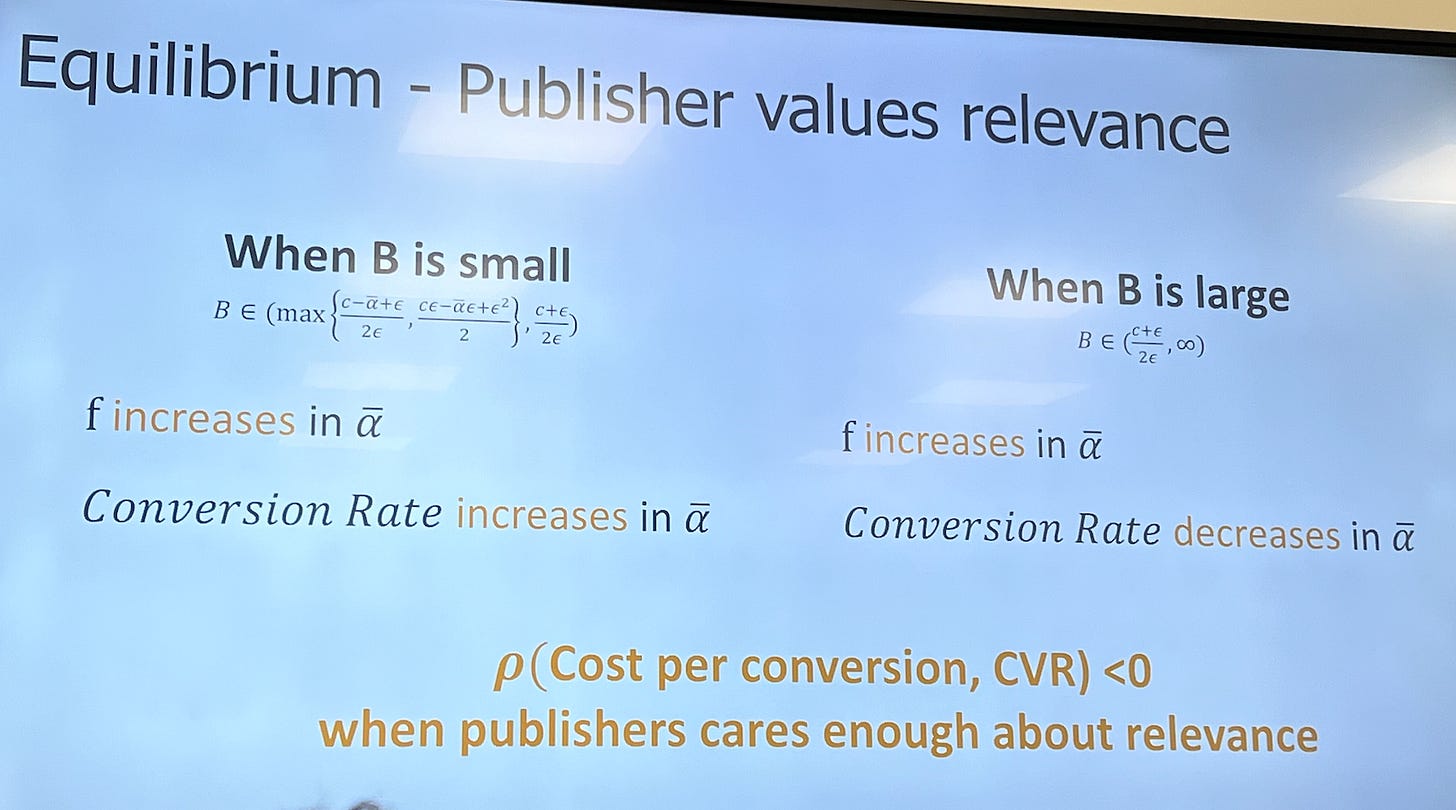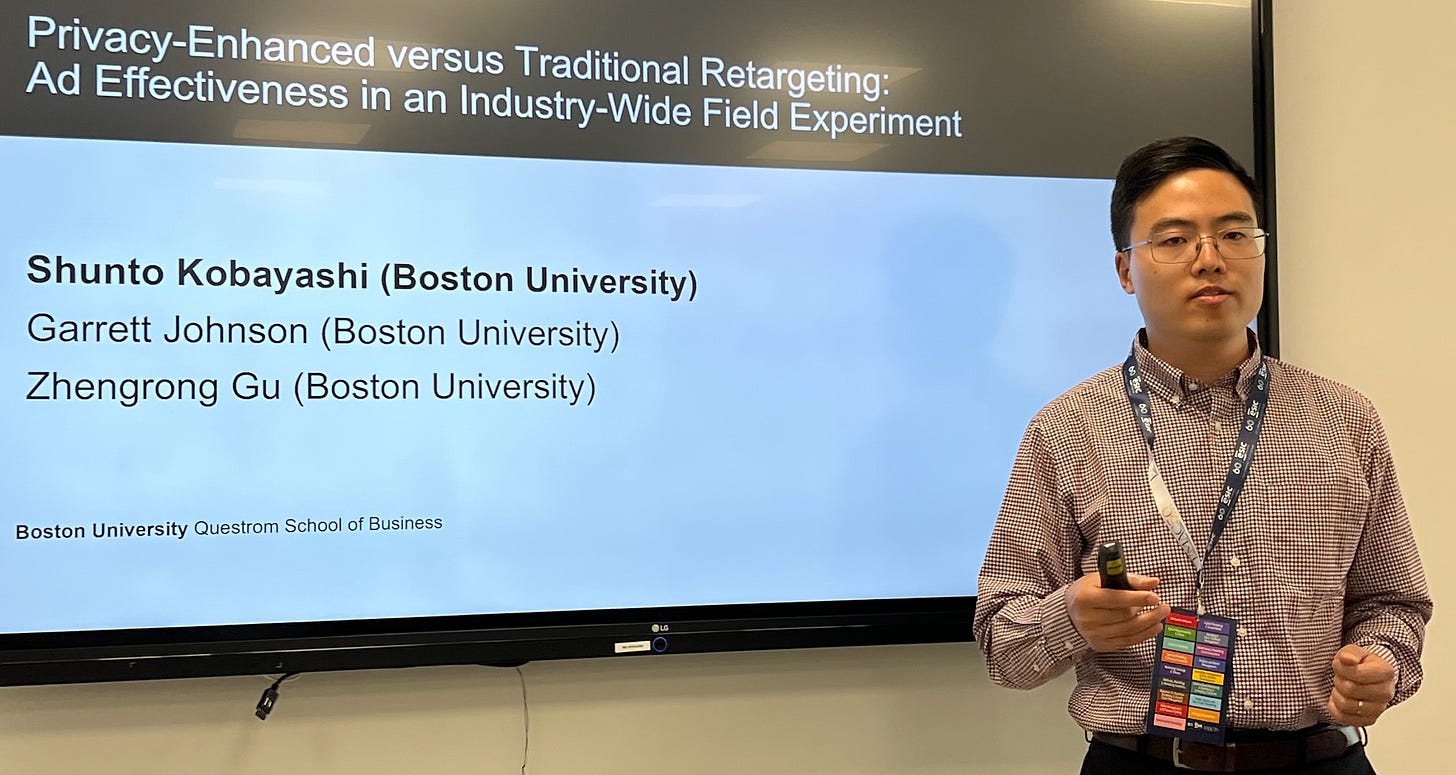Online Ad Effectiveness at EMAC 2025
Key takeaways on privacy, personalization, conversion and reach vs frequency
Last week, I had the privilege of chairing an exciting session on Online Advertising Effectiveness at the European Marketing Academy Conference. Four groundbreaking studies presented by top marketing scholars revealed key tradeoffs:
Online ad cost vs conversion
Privacy vs results in retargeting
Authenticity in firm-to-one vs firm-to-many messages
Reach vs frequency in digital Out-of-Home optimization
The Cost of Conversion Paradox
Manlu Ouyang (NYU Stern) tackled the paradox of the negative correlation between cost per conversion and conversion rate across digital platforms. While economic intuition suggests higher costs should yield better-quality ads with more conversions, real-world data shows the opposite:
Her game-theory model explains this counterintuitive relationship through publishers' emphasis on ad relevance in their quality scores. When platforms prioritize ad relevance alongside bid amounts, it creates market dynamics where better-converting ads often cost less:
This challenges traditional pricing models and offers marketers a more nuanced perspective on the relationship between quality, cost, and effectiveness in digital advertising.
I offered an alternative explanation for the negative correlation: marketers of high-margin products are willing to pay a lot for ads that don’t immediately convert, as they help the consumer along the purchase journey. This was my experience with non-endemic ads at Amazon, for e.g. high-margin vehicles and hospitality services. Note in the Wordstream data that the most expensive ads are for such high-margin products and services (> $100 CPC), which also see the lowest conversion rates ON THE PLATFORM. Our award winning research on retail media webrooming shows that most consumers search a lot at the online retailer, but buy the brand somewhere else.
Privacy-Enhanced Retargeting: good match but slow adoption
Shunto Kobayashi (Boston University) presented findings from a large-scale field experiment conducted with Google examining privacy-enhanced retargeting strategies for over 2,000 advertisers.
The good news? Privacy-enhanced retargeting achieves around 90% of the results of traditional retargeting:
The bad news: Privacy Sandbox technologies recover only half of TOTAL ad outcomes because it is supported only by a subset of vendors.
My main question is whether that reluctant advertiser acceptance of Google Sandbox is due to that lower vendor adoption, or rather because the 10% loss over traditional retargeting is judged too high. We know from Kinshuk Jerath and Klaus Miller’s research that consumers perceive this ‘privacy-friendly retargeting’ as NOT so privacy friendly, preferring instead contextual advertising. So if neither consumers nor advertisers like the Privacy Sandbox, why not make the leap to contextual?
Be Authentic and Vulnerable to 1 Consumer, not to all
Ceren Kolsarici (Queen's University) asks ‘R U 4 Real?’ or rather ‘Should you keep it real with your customers on social media?’ The answer, as always, is ‘It depends’. In this case, it depends on whether you are talking to all folks on the social media platform (Firm-to-Many, FTM), or to 1 customer as Firm-to-One (FTO) messages—personalized yet publicly visible responses to user-generated content.
Analyzing 127,000 tweets from Canadian financial institutions, she discovered that "genuine style"—authenticity, spontaneity, and approachability—drives engagement in FTO messages, but reduced it in FTM messages:
Surprisingly, emotional content reduces FTO effectiveness, while marketing-focused content enhances it. This counterintuitive finding challenges conventional wisdom that marketing content activates persuasion knowledge and triggers skepticism. Instead, in FTO contexts, marketing content appears more genuine and drives higher engagement.
The fourth presentation was mine, so I will turn that into its own post.
Implications for Marketing Practice
These studies collectively demonstrate how advanced measurement techniques can quantify marketing effectiveness across different channels:
Retail Media: Focus on ad relevance to improve conversion rates while potentially lowering costs
Retargeting: Embrace privacy-enhanced solutions that balance effectiveness with consumer privacy
Social media: Craft personalized responses that prioritize authenticity and marketing over emotional appeal, which is better for Firm-to-Many responses
Out-of-home: Demonstrate the causal impact and leverage digital to optimize exposure frequency and reach
What's Next for Online Ad Effectiveness?
As I prepare for my upcoming presentations and research, I'm reflecting on how these findings connect to the broader marketing accountability challenge.
What are your experiences with measuring marketing effectiveness? Are you seeing similar patterns in your own data? I'd love to hear your thoughts in the comments.
















